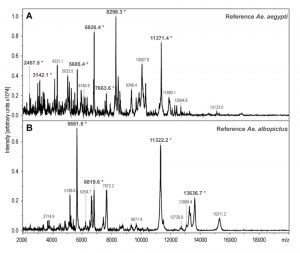Aedes Mosquitoes
Principal investigators: Kelly L. Bennett, Ari Whiteman, W. Owen McMillan & Jose R. Loaiza
Collaborators:Alejandro Almanza, Carmelo Gómez-Martínez, Jose Rovira, Gilberto Eskildsen & Jaime Cerro Medina
Background
Recently, geographically restricted forest-transmitted mosquito viruses such as Asian chikungunya (CHIKV) and African Zika (ZIKV) have become a growing health concern among novel urban areas worldwide. The successful invasion and establishment of these viral pathogens into new geographic areas is due to the increased presence of Aedes aegyptior Aedes albopictusmosquitoes. Both species thrive in urban settings because they can fulfill important ecological needs living alongside humans, including water for immature stage development, blood for female reproduction and shelter that protects larvae and adults against harsh climatic conditions. Indeed, the spatial distribution and localized relative presence of Aedesmosquitoes is often used as a direct predictor of where disease outbreaks are likely to occur in human populations, hence it is important to identify the drivers of Aedespopulation dynamics in urban areas.
In 2002, Aedes. albopictuswas introduced for the first time into Panama and has since proliferated mostly across rural regions of the country. In urban Panama City though, resident Aedes aegyptican be found solely or alongside Aedes albopictus. At the macroecological scale the current distribution of both Aedesspecies seems to be governed by a combination of multiple invasion events into the Isthmus of Panama, human-assisted dispersal through the primary road system and biological competition between rural and urban environments.
Findings & developments
- A pattern of multiple introductions of both Aedes aegyptiand Aedes albopictusmosquitoes into Panama has been uncovered, which is important for the establishment of sustainable surveillance and control strategies against these vectors and the diseases they transmit.
- Aedes aegyptiand Aedes albopictusare more commonly found in neighborhoods of Panama City with low socioeconomic status, as compared to those with a high socioeconomic status. This includes the level of education and the monthly salary of the inhabitants of these neighborhoods as explanatory variables for the increased Aedesabundance and risk of disease transmission.
- Lower relative knowledge and fewer practices related to the prevention of DENV, CHIKV, and ZIKV are found in communities of lower socioeconomic status (SES). Low-SES communities with high proportions of low-income residents, low education, and elderly residents should be the target of arbovirus prevention programs.
- Aedes albopictusis spatially displacingAedes aegyptiin some rural areas of Panama to become the main disease vector there, which has implications for the control of mosquitoes, since current efforts in Panama are focused only on Aedes aegypti.
Relevant publications
- Eskildsen A. Gilberto, Rovira Jose, Smith Octavio, Kelly L. Bennett, Miller Matthew, W. Owen McMillan, Loaiza JR.† 2018. Maternal invasion history of Aedes aegypti and Aedes albopictus into the Isthmus of Panama: Implications for the control of emergent viral disease agents. Plos One 13(3): e0194874.
- Bennett KL, Carmelo Gómez-Martínez, Alejandro Almanza, Jose R. Rovira, W. Owen McMillan, Vanessa Enriquez, Elia Barraza, Marcela Díaz, Javier Sanchez Galan, Ari Whiteman, Rolando A. Gittens, Loaiza JR.† High infestation of invasive Aedes mosquitoes in used-tyres along the local transport network of Panama. Parasites and Vectors, 12: 264.
- Whiteman A, Gomez C, Rovira J, Loaiza JR, Chen G. Aedes mosquito infestation in socioeconomically contrasting neighborhoods of Panama City. EcoHealth, doi: 10.1007/s10393-019-01417-3.



